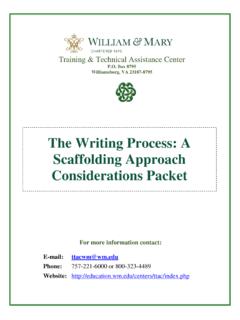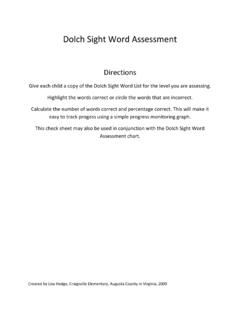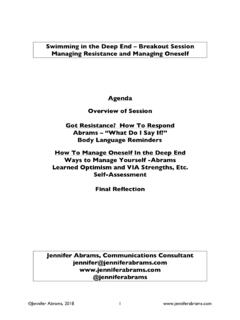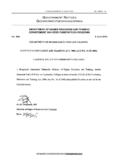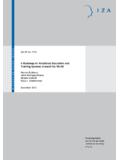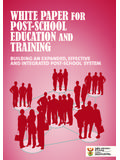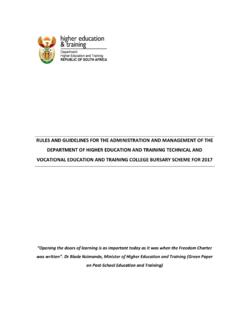Transcription of Adolescent Literacy: Evidence-Based Instructional ...
1 training & Technical Assistance Center Box 8795. Williamsburg, VA 23187-8795. Adolescent literacy : Evidence-Based Instructional Strategies - Why, What, and How For more information contact: E-mail: Phone: 757-221-6000 or 800-323-4489. Website: 2. Adolescent literacy : Evidence-Based Instructional Strategies - Why, What, and How (All links are listed at the end of this document and are hyperlinked to the words highlighted in blue.). Reading achievement among adolescents has become a national concern highlighted by the National Assessment of Educational Progress (NAEP) results reported over the last 10 years (NAEP, 2009). These data show little progress in fourth- and eighth-grade reading comprehension skills over the past decade, with 30% of students in eighth grade reading two or more grade levels below their enrolled grade (Alliance Fact Sheet, September 2010). The most recent OECD Programme for International Student Assessment (PISA; 2009) results mirror these concerns, with the United States ranked 14th among all participating nations in reading skills.
2 On a more local level, data from the Virginia Standards of Learning (SOL) assessment indicate that only two-thirds of Virginia students with disabilities in grades 4 through high school meet the required minimal level of mastery of grade-level reading standards. While improvement has been noted, and multiple measures ( , Virginia Grade Level Alternative -VGLA) have been provided, students with disabilities continue to be challenged in meeting the minimal standards in reading across the state and nation. This dismal situation has prompted questions about the future capacity of this group to assume productive leadership roles within an increasingly global culture. Experts have weighed in with Instructional recommendations to address this area of ever-growing concern. Pivotal reports outlining Instructional and systemic recommendations for improving Adolescent literacy have been published, beginning with the National Reading Panel's report in 2000 and continuing with Reading Next in 2004.
3 The What Works Clearinghouse (2008), through the Institute for Educational Sciences established in 2002 to measure educational outcomes, has published five recommendations for improving Adolescent literacy . Likewise, The Center on Instruction (2007) has published a set of recommendations. Further, the PISA report (2009) provides guidance for instruction, including (a) quality of instruction outweighs quantity, and (b) metacognitive competencies are critical to moving students forward in developing higher level skills. In addition, Dr. Don Deshler from the University of Kansas Center for Research on Learning (2009) has prioritized the recommendations from these reports and others to focus educators' work with this age group. The chart below summarizes the recommendations from these reports and presentations. Considerations Packet: Adolescent literacy T/TAC W&M. Updated: 08/2011.
4 3. What Works Clearinghouse (WWC) Adolescent Center on Instruction (COI) Academic literacy literacy : Effective Classroom and Intervention Instruction for Adolescents: A Guidance Practices (August 2008) Document from the Center on Instruction (March, Each recommendation is linked to a PowerPoint 2007). provided through the University of Oregon, 2009. Conference Follow-Up: Improving Adolescent literacy : Effective Classroom and Intervention Practices; presentation highlights, audio clips, and handouts from the main author, Michael Kamil. Recommendation 1: Provide explicit vocabulary Recommendation 1: Provide explicit instruction instruction (Strong evidence ) and supportive practice in the use of effective comprehension strategies throughout the school day Recommendation 2: Provide direct and explicit Recommendation 2: Increase the amount and comprehension strategy instruction (Strong quality of open, sustained discussion of reading evidence ) content Recommendation 3: Provide opportunities for Recommendation 3: Set and maintain high extended discussion of text meaning and standards for text, conversation, questions, and interpretation (Moderate evidence ) vocabulary Recommendation 4: Increase student motivation Recommendation 4: Increase students' motivation and engagement in literacy learning (Moderate and engagement with reading evidence ).
5 Recommendation 5: Make available intensive and Recommendation 5: Teach essential content specialized interventions for struggling readers knowledge so that all students master critical that can be provided by trained specialists (Strong concepts evidence ). Deshler's Summary of Recommendations: 5 Questions for Moving the Needle on Adolescent literacy (2009). Explicit vocabulary instruction Direct and explicit comprehension strategy instruction Sustained discussion of subject matter content Emphasis on mastery of essential content Increased engagement in literacy experiences that motivate Considerations Packet: Adolescent literacy T/TAC W&M. Updated: 08/2011. 4. The ultimate goal of all reading events is to make meaning of what we have read. Comprehending text involves a complex process of intertwining skills as visually demonstrated through Scarborough's Reading Rope (2001).
6 Scarborough's Reading Rope (2001). LANGUAGE COMPREHENSION. Background Knowledge Vocabulary Knowledge Language Structures SKILLED READING: Verbal Reasoning fluent execution and literacy Knowledge coordination of word recognition and text comprehension. WORD RECOGNITION. Phonological Awareness Decoding (and Spelling). Sight Recognition Reading is a multifaceted skill, gradually acquired over years of instruction and practice. p. 54. (Hennessey, 2009). Language Knowledge: Word Knowledge: Background Knowledge (facts, culture, concepts) Phonological Awareness Vocabulary Knowledge (breadth; , # of known Decoding and Spelling words), precision (morphology, usage), links/depth). Language Structures (semantic and syntax) Sight Recognition Verbal Reasoning (comprehension skills, such as inferencing and metaphors). literacy Knowledge (genres, conventions of print, etc.). Comprehending the text being read involves the interplay of a variety of skills ( , background knowledge, vocabulary knowledge, decoding skills, and verbal reasoning).
7 These skills work together at various levels of intensity depending on the requirements of the task at hand. Comprehending text is a process, not an end product (Carlisle & Rice, 2002), and it is not accomplished through a precise formula of equally interacting skills. When reading a passage concerning Mexico, for example, prior knowledge of aspects of this topic would be helpful in comprehending the passage. If the passage is at the seventh- grade level, but the reader struggles with vocabulary at that grade level, the level of comprehension of the passage is diminished. If, further, the student struggles with decoding at even the fourth-grade level, the speed and accuracy with which the student reads the passage and then comprehends it will be significantly compromised. Considerations Packet: Adolescent literacy T/TAC W&M. Updated: 08/2011. 5. Instructional practices to target Adolescent literacy in general education classrooms focus on the Language Knowledge strands whereas intensive interventions for adolescents focus on the Word Knowledge and Language Knowledge strands.
8 Throughout the literature on literacy instruction specific to reading, before, during and after reading strategies are encouraged to intensify and organize reading events, and to ensure a successful outcome comprehension and application of the text information. Before, during, and after reading strategies are discussed throughout the literature on literacy strategies and skill acquisition; they may be summarized as having the following purposes. Before Reading Activities During Reading Activities After Reading Activities Purposes: Purposes: Purposes: Activate prior knowledge Engage with the text Reflect on the content of Generate questions Self-monitor the lesson Discuss vocabulary comprehension Examine questions that Build background Summarize text guided reading knowledge Integrate new Respond to text through Make predictions information with prior writing Establish a purpose for knowledge Evaluate predictions reading Verify and formulate Respond to text through predictions discussion Construct graphic Retell or summarize organizers Use mental imagery Alabama Reading Initiative Secondary Team (2008).
9 A variety of Instructional strategies are available at each point of the reading event to address the needs of struggling students. The chart below provides descriptions of strategies that support the recommendations and reading rope strands presented earlier. (The Before, During, and After Strategy Links may be accessed at ). Before Reading Instructional Expert Recommendation That Reading Rope Strand Strategy Supports the Instructional Supported by the Instructional Strategy Strategy Anticipation Guide (Beers, 2003; WWC Recommendation #2, Language Knowledge: Gallagher, 2004; Rozzelle & COI Recommendation #1, Background Knowledge Scearce, 2009; Tovani, 2001, and Deshler's Recommendation 2004) for direct and explicit comprehension strategy instruction Frontloading Vocabulary (Stowe, WWC Recommendation #1, Language Knowledge: 2009) COI Recommendation #2 and Vocabulary #5, and Deshler's Recommendation for explicit vocabulary instruction Considerations Packet: Adolescent literacy T/TAC W&M.
10 Updated: 08/2011. 6. Scavenger Hunt and Variations WWC Recommendation #2, Language Knowledge: (Fisher, Brozo, Frey, & Ivey, COI Recommendation #1, and literacy Knowledge: scavenger 2007; Rozzelle & Scearce, 2009) Deshler's Recommendation for hunt variation might target other direct and explicit reading strands such as comprehension strategy vocabulary instruction Tea Party (Beers, 2003) WWC Recommendation #3 and Language Knowledge: #4, COI Recommendation #2 Background Knowledge and #4, and Deshler's Recommendation for Increased engagement in literacy experiences that motivate Use of Lexile Levels (TTAC WM, WWC Recommendation #4, Language Knowledge: 2008) COI Recommendation #4, and Vocabulary, Language Deshler's Recommendation for Structures, Verbal Reasoning, increased engagement in literacy and literacy Knowledge experiences that motivate Word Knowledge: Decoding and Spelling Teaching Morphology (Birsh, WWC Recommendations #1 Language Knowledge: 2005; Soifer,2005; Wilson, 2005; and #5; COI Recommendations Vocabulary Precision Yoshimoto, 2009) #1 and #5.

